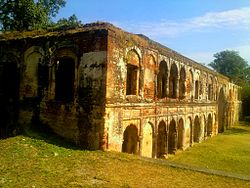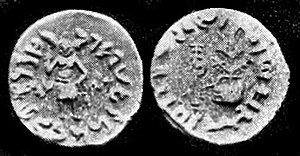A | B | C | D | E | F | G | H | CH | I | J | K | L | M | N | O | P | Q | R | S | T | U | V | W | X | Y | Z | 0 | 1 | 2 | 3 | 4 | 5 | 6 | 7 | 8 | 9
This article possibly contains original research. (June 2019) |
Gurdaspur district | |
|---|---|
 Sujanpur Fort | |
 Location in Punjab | |
| Coordinates: 31°55′N 75°15′E / 31.917°N 75.250°E | |
| Country | |
| State | Punjab |
| Headquarters | Gurdaspur |
| Area | |
| • Total | 2,610 km2 (1,010 sq mi) |
| Population (2011)[‡] | |
| • Total | 2,298,323 |
| • Density | 880/km2 (2,300/sq mi) |
| Languages | |
| • Official | Punjabi |
| Time zone | UTC+5:30 (IST) |
| Vehicle Code | PB 06,PB 18,PB 58,PB 85, PB 99 |
| Literacy | 79.95% |
| Website | gurdaspur |
Gurdaspur district is a district in the Majha region of the state of Punjab, India. Gurdaspur is the district headquarters. It internationally borders Narowal District of Pakistani Punjab, and the districts of Amritsar, Pathankot, Kapurthala and Hoshiarpur. Two main rivers Beas and Ravi passes through the district. The Mughal emperor Akbar is said to have been enthroned in a garden near Kalanaur, a historically important town in the district.[1] The district is at the foothills of the Himalayas.
As of 2011 it is the third most populous district of Punjab (out of 22), after Ludhiana and Amritsar.[2] Batala, with 31% of the district's population, is its largest city.
History

Obv: Standing figure, probably of Vishvamitra, Kharoshthi legend, around: Mahadevasa Dharaghoshasa/Odumbarisa "Great Lord King Dharaghosha/Prince of Audumabara", across: Viçvamitra "Vishvamitra".
Rev: Trident battle-axe, tree with railing, Brahmi legend identical in content to the obverse.[3]
Medieval period
This area was used as a base by Banda Singh Bahadur to raid the area up to Lahore. The Mughal emperor Bahadur Shah conducted an expedition against him in 1711, but with only temporary effect. Banda Singh Bahadur fought his last battle against Mughals at Gurdas Nangal and was captured.[4][5]
On 17 May 1746, the Chhota Ghallughara (smaller Sikh genocide) took place. Approximately 10,000 to 15,000 Sikhs were killed in battle on a single day in Kahnuwan, near Gurdaspur. Under the Lahore governorship of Yahiya Khan, Lakhpat Rai (revenue minister) and Shah Navaz Khan were directed to avenge the killing of Lakhpat Rai's brother, Jaspat Rai. An official decree to exterminate Sikhs was issued.[citation needed]
In about 1633 CE, during the rule of Shah Jahan, the Badshahi canal was constructed for carrying waters to the Shalimar Gardens at Lahore. Maharaja Ranjit Singh constructed Hansali canal to carry waters to the tank of the Golden Temple.[6]
British Raj

The district of Gurdaspur came into being in April 1846 after the annexation of Punjab by the British.[7] During British Rule the district of Gurdaspur was a subdivision of Lahore Division, the district itself was administratively subdivided into four tehsils: Gurdaspur, Batala, Shakargarh and Pathankot. During the India's first war of independence, on 12 July 1857, battle of Trimmu Ghat was fought between the forces of British and Indian rebel sepoys on the left bank of Ravi.[8]Trimmu Ghat was about 9 miles west of Gurdaspur city in the district. Most of the Indian rebel sepoys were killed in the battle.[9]
According to the 1881 census the population of the district was 823,695 this had risen by over 100,000 to 943,922 in the 1891 census. However, the 1901 census recorded a fall in population – 940,334, this was largely due to emigration – some 44,000 settlers settling in Chenab colony. According to the 1901 census there were 463,371 Muslims (49%), 380,636 Hindus (over 40%) and 91,756 (10%) Sikhs. Mirza Ghulam Ahmad who founded the Ahmadiyya movement had followers here.[10]
During the partition of India in 1947 the future of Gurdaspur was highly contested. According to the 1941 census, the population of this district had a narrow 51.14% Muslim majority. Radcliffe Award of the boundary gave only the Shakargarh tehsil of the district to Pakistan, and the rest to India. The Muslim population of the eastern tehsils migrated to Pakistan as refugees, and the Hindus and Sikhs of Shakargarh migrated to Gurdaspur after crossing the Ravi Bridge. They settled and spread in the Gurdaspur district. According to the 1951 census, there were around 2,97,581 displaced persons who had settled in the district, who formed about 34.96% of the district population.[11] Of the total displaced persons 1,59,716 were males and 1,37,865 females. The origin of most of them were pakistani districts of Sialkot (1,93,182), Shakargarh (43,203), Lyallpur (17,783) and Shekhupura (8,826).[12]
Modern India
New tehsil of Dera Baba Nanak was created in 1995 and Dhar Kalan in 1996.[13] On 27 July 2011 a part of district was carved out to form a new Pathankot district, which was earlier part of Gurdaspur. The Pathankot district comprises two sub-divisions of Pathankot and Dharkalan along with two sub-tehsils namely Narot Jaimal Singh and Bamial.
Geography
Location
The Gurdaspur district is in the north of Punjab state. It falls in the Jalandhar division and is sandwiched between rivers Ravi and Beas. The district lies between north-latitude 31°36' and 32°34' and east longitude 74°56' and 75°24' and shares common boundaries with Pathankot district in the north, Beas River in the north-east, Hoshiarpur district in the south-east, Kapurthala district in the south, Amritsar district in the south-west and Pakistan in the north-west.
Government and politics
Politics
| No. | Constituency | Name of MLA | Party | Bench | |
|---|---|---|---|---|---|
| 4 | Gurdaspur | Barindermeet Singh Pahra | Indian National Congress | Opposition | |
| 5 | Dina Nagar (SC) | Aruna Chaudhary | Indian National Congress | Opposition | |
| 6 | Qadian | Partap Singh Bajwa | Indian National Congress | Opposition | |
| 7 | Batala | Amansher Singh (Shery Kalsi) | Aam Aadmi Party | Government | |
| 8 | Sri Hargobindpur (SC) | Amarpal Singh | Aam Aadmi Party | Government | |
| 9 | Fatehgarh Churian | Tripat Rajinder Singh Bajwa | Indian National Congress | Opposition | |
| 10 | Dera Baba Nanak | Sukhjinder Singh Randhawa | Indian National Congress | Opposition | |
Tehsil
|
Sub Tehsils (Total : 7)
| Sr. No. | Sub Tehsil Name |
|---|---|
| 1. | Kahnuwan |
| 2. | Sri Hargobindpur |
| 3. | Qadian |
| 4. | Fatehgarh Churian |
| 5. | Dhariwal |
| 6. | Naushera Majha Singh |
| 7. | Dorangla |
C.D. Blocks (Total : 11)
| Sr. No. | Block Name |
|---|---|
| 1. | Gurdaspur |
| 2. | Kalanaur |
| 3. | Dhariwal |
| 4. | Kahnuwan |
| 5. | Dinanagar |
| 6. | Batala |
| 7. | Fatehgarh Churian |
| 8. | Dera Baba Nanak |
| 9. | Sri Hargobindpur |
| 10. | Qadian |
| 11. | Dorangla |
Municipal Corporation (Nagar Nigam)
| Sr. No. | Corporation Name |
|---|---|
| 1. | Batala |
Municipal Councils
| Sr. No. | Municipal Name |
|---|---|
| 1. | Gurdaspur |
| 2. | Dhariwal |
| 3. | Dinanagar |
| 4. | Sri Hargobindpur |
| 5. | Dera Baba Nanak |
| 6. | Fatehgarh Churian |
| 7. | Qadian |
Villages
| Sr. No. | Village Name |
|---|---|
| 1. | Bangowani |
| 2. | Zahadpur |
| 3. | Khojala |
| 4. | Barnala |
| 5. | SaduChak |
| 6. | Kohali (Gurdaspur District) |
| 7. | Talwandi Jheuran |
Demographics
Population
| Year | Pop. | ±% p.a. |
|---|---|---|
| 1901 | 702,372 | — |
| 1911 | 622,008 | −1.21% |
| 1921 | 634,394 | +0.20% |
| 1931 | 718,523 | +1.25% |
| 1941 | 854,968 | +1.75% |
| 1951 | 851,140 | −0.04% |
| 1961 | 980,868 | +1.43% |
| 1971 | 1,229,464 | +2.28% |
| 1981 | 1,513,435 | +2.10% |
| 1991 | 1,756,732 | +1.50% |
| 2001 | 2,103,455 | +1.82% |
| 2011 | 2,298,323 | +0.89% |
| source:[14] | ||
According to the 2011 census Gurdaspur district has a population of 2,298,323,[2] roughly equal to the nation of Latvia[15] or the US state of New Mexico.[16] This gives it a ranking of 196th in India (out of a total of 640).[2] The district has a population density of 649 inhabitants per square kilometre (1,680/sq mi).[2] Its population growth rate over the decade 2001–2011 was 9.3%.[2] Gurdaspur has a sex ratio of 895 females for every 1000 males,[2] and a literacy rate of 79.95%.[2]
After the separation of the Pathankot tehsil into a separate district in 2011, the residual district has a population of 1,621,725 of which 1,260,572 were rural and 361,153 were urban. Scheduled Castes have a population of 373,544 (23.03%) of the population. Punjabi is the predominant language, spoken by 98.27% of the population.[17]
Gender
The table below shows the sex ratio of Gurdaspur through the years, according to various census years.[18] Note:- The figure for 2011 does not include the data of the areas that currently form Pathankot district, which were separated from Gurdaspur on that year, to form a new district.
| Year
(Census) |
Sex Ratio |
|---|---|
| 2011 | 907 |
| 2001 | 890 |
| 1991 | 903 |
| 1981 | 907 |
| 1971 | 890 |
| 1961 | 869 |
| 1951 | 846 |
| 1941 | 843 |
| 1931 | 809 |
| 1921 | 794 |
| 1911 | 774 |
| 1901 | 853 |
The table below shows the child sex ratio of children below the age of 6 years in the rural and urban areas of Gurdaspur district. Note:- The data till year 2001 also includes the data from the areas currently in the Pathankot district.
| Year | Urban | Rural |
|---|---|---|
| 2011 | 828 | 818 |
| 2001 | 762 | 797 |
Rural and Urban
The table below shows the percentage of rural population through the decades.[21] Note:- The separation of the areas in the current Pathankot district in 2011, may have significantly changed the numbers and figures for that year.
| Year | Percentage |
|---|---|
| 2011 | 77.73% |
| 2001 | 74.56% |
| 1991 | 78.02% |
| 1981 | 78.31% |
| 1971 | 79.7% |
The table below gives the absolute number of rural and urban population through the years.[23][24] Note:- The separation of the areas in the current Pathankot district in 2011, may have significantly changed the numbers and figures for that year.
| Year | Urban | Rural |
|---|---|---|
| 2011 | 3,61,153 | 12,60,572 |
| 2001 | 5,35,223 | 15,68,788 |
| 1991 | 3,86,412 | 13,71,796 |
| 1981 | 3,28,268 | 11,85,167 |
| 1971 | 2,49,084 | 9,80,165 |
Religion
Text je dostupný za podmienok Creative
Commons Attribution/Share-Alike License 3.0 Unported; prípadne za ďalších
podmienok.
Podrobnejšie informácie nájdete na stránke Podmienky
použitia.

